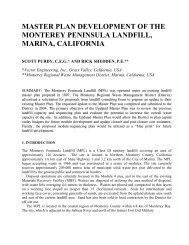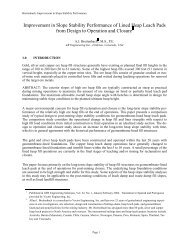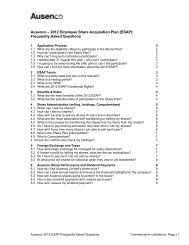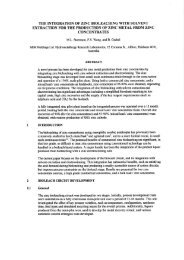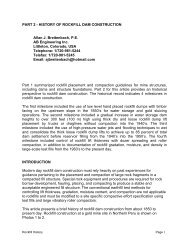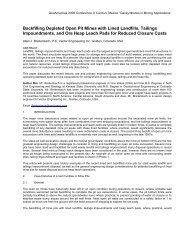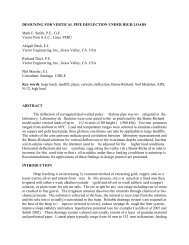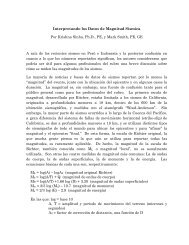Summary of Rockfill Placement and Compaction ... - Ausenco
Summary of Rockfill Placement and Compaction ... - Ausenco
Summary of Rockfill Placement and Compaction ... - Ausenco
Create successful ePaper yourself
Turn your PDF publications into a flip-book with our unique Google optimized e-Paper software.
Gradation:overlap the edge <strong>of</strong> preceding passes for 100 percent roller pass coverage on thesurface. As a general "rule <strong>of</strong> thumb", the acceptable number <strong>of</strong> roller passes shouldbe set at 80 percent <strong>of</strong> the total surveyed settlement in eight passes on a testsection, according to Corps <strong>of</strong> Engineers test procedures. The average settlement <strong>of</strong>at least 5 survey control points is recommended for each 2 passes <strong>of</strong> the rollercompactor to determine the acceptable number <strong>of</strong> passes.<strong>Rockfill</strong>s for compacted dam structures are generally placed in transitional zoneswith the most coarse <strong>and</strong> competent rock placed in the outer shell <strong>and</strong> finer moreweathered rock placed in the interior or adjacent to earthfill filter drain <strong>and</strong> corematerials. A similar transition zone is developed for leach pad site grading fills withthe finer rock materials placed beneath the pad soil subgrade <strong>and</strong> overlyinggeomembrane liner system.Well-graded rockfills with small voids tend to increase the in-place density <strong>and</strong>provide a stable mass for minimizing post-construction settlement. Poorly gradedrock with large voids is sometimes desirable on the upstream shell <strong>of</strong> a waterstorage reservoir for drainage during reservoir rapid drawdown conditions <strong>and</strong> inspillway areas for erosion protection <strong>and</strong> energy dissipation.Oversized rocks are generally placed on the downstream or exterior rockfill slopes<strong>and</strong> in downstream outlet/spillway plunge pools for erosion <strong>and</strong> energy dissipationpurposes. Occasional extremely large oversized rock can be incorporated intorockfills provided no overhangs occur <strong>and</strong> the surrounding rockfill is compactedagainst the large rock pieces similar to compaction techniques against the rockabutments. Phased downstream raises to existing rockfill dams can incorporate thenew rockfill into the oversized rock on the downstream slope <strong>of</strong> an existing damprovided the large rocks are not clustered.Moisture Conditioning:In the past, rockfills for water storage embankments were dumped in thick loose lifts<strong>of</strong> typically 35 to 165 feet (11 to 50 m) <strong>and</strong> flooded with water to consolidate therockfill to about 85 percent <strong>of</strong> its total settlement. Modern rockfills since the 1960'sare placed in thin controlled lifts <strong>and</strong> compacted with vibratory compactors so thatmoisture conditioning requirements are not as critical to minimize post-constructionsettlement. Wetting is generally accomplished on the fill area unless water truckshave access to the rock borrow area. As with earthfill materials, moistureconditioning is desirable in the rock borrow areas for better mixing <strong>of</strong> moisture <strong>and</strong>materials during excavation, loading, dumping, <strong>and</strong> spreading for compaction.However, development <strong>of</strong> rock borrow areas involves blasting or ripping operationsthat sometimes make the borrow surface too rugged for conventional water truckswith spray bars.<strong>Rockfill</strong> Guidelines 3



